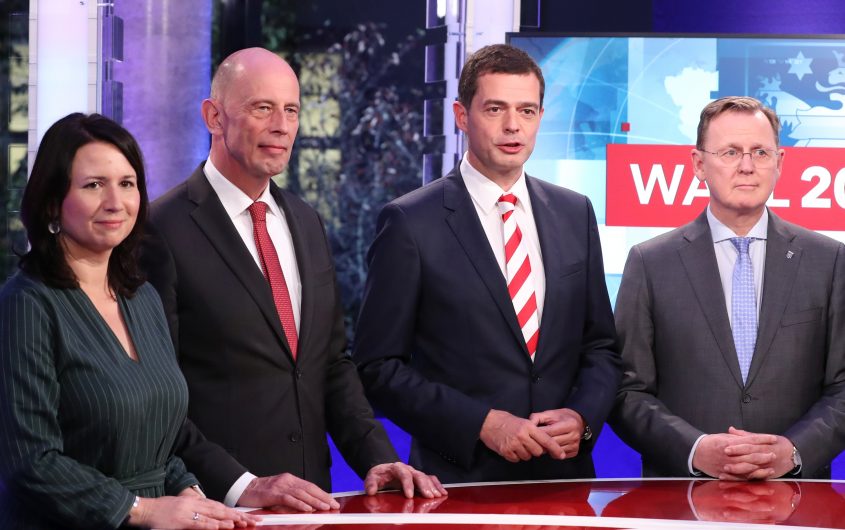
Sandro Halank via Wikimedia Commons
The 2019 Thuringia Elections: New Winners, Tough Challenges

Leon Lieblang
University of Duisburg-Essen
Leon Arvid Lieblang is a former NRW Fellow at AICGS in October and November 2019. He is a research assistant and PhD candidate at the University of Duisburg-Essen, Germany.
Mr. Lieblang’s research focuses on climate and renewable energy policy. he lectures on energy policy and public administration. Mr. Lieblang holds a bachelor’s degree in Politics, Law, and Economics from the University of Erfurt and a master’s degree in Political Management, Public Policy, and Public Administration from the NRW School of Governance. Additionally, he has studied abroad at Sciences Po Lyon, France, and at the Uniwersytet Jagielloński in Kraków, Poland.
Prior to his PhD studies, Mr. Lieblang worked as an advisor at the Ministry of Economic Affairs and Energy of North Rhine-Westphalia. In his position in the Minister’s Office, his responsibilities included strategic planning, coordinating the state government’s agenda, and writing speeches for the minister.
During his stay at AICGS, he worked on U.S. climate policy at the state and federal levels. His research compared various U.S. states' approaches to dealing with U.S. withdraw from the Paris Agreement announced by President Donald Trump. Specifically, Mr. Lieblang assessed which states are developing their own climate agendas, their motivations for doing so, and possible relevant explanatory factors.
Please feel free to contact Mr. Lieblang at leon.lieblang@uni-due.de.
With Sunday’s vote in Thuringia, the 2019 election year in Germany came to an end. Following several state elections, including in Saxony and Brandenburg, approximately 1.7 million voters went to elect a new parliament. With an overall population of 2.1 million in Thuringia—less than in Berlin—the results would normally not draw too much attention. But, as has been said before, the current political situation in Germany is far from normal. On the contrary: The day after the elections, the outcome sent several shockwaves to Berlin. A closer look reveals how a lot of firsts challenged the German party system and might have a long-lasting impact.
A first glimpse at the raw figures suffices to underline the election’s historic character. The Left (“Die Linke”) won the elections with 31 percent, followed by the Alternative for Germany (AfD) with 23.4 percent. The Conservatives (CDU) reached 21.8 percent, the Social Democrats (SPD) 8.2 percent, Greens 5.2 percent, and the Liberals (FDP) re-entered the parliament with 5 percent. Other parties totaled 5.4 percent.
Ramelow was able to establish something that a lot of minister-presidents reach for but only a few achieve: an image of being “Landesvater”
Clearly, the red-red-green coalition lost its majority. That may come as a surprise, considering that 58 percent were satisfied with this first-of-its-kind coalition and that the Left performed well in the election. Their minister-president Bodo Ramelow—the only minister-president from the Left and, apart from Winfried Kretschmann, the only one with no Conservative or Social Democrat party affiliation—was able to improve the already outstanding result from the last elections by 2.8 percentage points. One of the key factors to understand these dynamics is the popularity of the minister-president, of whom 70 percent of the voters say that he is a “good minister-president.” This is especially noteworthy considering that the outcome follows significant losses for the Left in the last two elections earlier this fall in the new Länder, where the party only reached around 10 percent. This turnaround can furthermore be linked to the “Amtsbonus,” describing the fact that minister-presidents usually perform well, regardless of their party affiliation. We have seen this before, most recently in Baden-Württemberg or in Lower Saxony. Finally, based on his approval numbers, Ramelow was able to establish something that a lot of minister-presidents reach for but only a few achieve: an image of being “Landesvater” (or “Landesmutter”), and the perception of governing somehow above party lines. As a consequence, the Left not only had its best-ever election outcome on the Länder level ever. It is also the first time that the Left acquired more votes than any other party in an election.
A typical voter of the AfD in Thuringia lives in a rural area where population is shrinking rapidly. And that is happening almost everywhere.
The second winner is the AfD. It was able to more than double its 2014 result (23.4 percent versus 10.6 percent). It may have not reached the 27.5 percent of the Saxony elections, but with 23.4 percent it challenged the Brandenburg result of 23.5 percent. The AfD, established in 2013, took second place in each of these last three elections, which all took place in the East. Even though the AfD is generally known for its national, far-right positions, it is notable that almost one-fourth of the voters in Thuringia voted for a party led by Björn Höcke, a frontrunner who is well-known for his especially provocative, extreme, and völkisch positions. A recent court ruling allowed protestors to call him a “fascist” based on, as the court stated, a “verifiable factual basis.” Some clear examples can be found in his 2018 published book where he evokes a “people’s death through population exchange,” claiming the necessity of a “huge re-migration project” and stating that if power shifts, a “policy of well-tempered cruelty” is inevitable. Even if 82 percent of all voters indicate that the party does not distance itself enough from right-wing extremist positions, 77 percent of the AfD voters do appreciate that he does not mince words. Most important for their voters, however, were the topics of immigration, wages/rents, and criminality. According to polls, a typical voter of the AfD in Thuringia is young (it was the most popular party for all age brackets except for those over 60), a blue-collar worker, and lives in a rural area where population is shrinking rapidly. And that happens almost everywhere: Considering that all electoral districts in Thuringia but one (its capital, Erfurt) are shrinking, this could hold as one explanatory factor for the outcome. Yet, it is noteworthy as well that more than every second voter of the AfD based his or her decision on disappointment.
The losers of the election are clearly the parties of the Berlin grand coalition. Christian Democrats and Social Democrats reached an accumulated 30 percent. The CDU lost 11.7 percentage points in comparison with the last Thuringia elections, now ranking third after the Left and the AfD. Losses were seen in the two other fall elections in the East, however, a loss of more than 10 percentage points is still unusual, resulting in another first: For the first time in Thuringia, the Christian Democrats do not have the highest voter turnout. That puts even more pressure on CDU party leader Annegret Kramp-Karrenbauer, already facing rising criticism within her own party. As with the SPD, voters criticize that the national coalition made a lot of promises, few of which were kept. For the SPD, people are especially critical of a missing leadership in the party and that it is not clear what the party stands for. With a result of less than 10 percent, from now on the party will only play a marginal role in Thuringia. For the Social Democrats in Thuringia, it is the worst outcome so far.
The third big loser are the Greens. Whereas on the national level, polls show approval rates of 20 percent and more, an outcome of 5.2 percent in Thuringia is way below party expectations. Even though they did perform well in larger cities, in rural areas and small cities approval rates are as low as 4 percent. Voters especially criticize a radical climate policy and too many regulations, leading to a feeling that the party tries to dictate people’s way of life. This brings back memories from 2011 and beyond, where the Greens performed well in national polls after the Fukushima incident, lifting the party to above 20 percent in polls before eventually reaching 8.4 percent in the national elections of 2013. For the first time since the polls moved up significantly a year ago, the Greens have to deal with a below-average performance in elections.
Finally, there are the Liberals, which came in above the 5 percent threshold—by five votes, according to the preliminary results, receiving 5.0005 percent of all votes. It was the first time in the latest three German elections in the East that the FDP was able to overcome this threshold. This was especially important for Christian Lindner, leader of the Liberals, who has recently faced increasing pressure from within the party. Even though it is questionable whether criticism will vanish, re-entering a parliament in the East for the first time after ten years is a success for the party leader.
The election shows three major consequences: The “Mitte” shrank significantly. The extreme forces within the AfD came out of the elections strengthened. The German party system faces great challenges.
Apart from local impacts, the election shows three major consequences for Germany as a whole. First, the “Mitte” (center) shrank significantly. A strong turnout for the Left and AfD led to a situation where, for the first time in postwar Germany, the CDU, SPD, FDP, and Greens are without the majority. With 90 seats in parliament and therefore a majority of 46 seats needed, they run short of no less than 7 seats. In other words: A four-party coalition, including a “grand coalition” has no majority—a first in Germany. “Die Mitte,” it appears, has shrunk significantly.
Second, extreme forces within the AfD came out of the elections strengthened. Höcke is arguably the most popular representative of the Flügel, the far-right group within the AfD. Additionally, it should not be overlooked that with the Saxony and Brandenburg elections, two other members of the Flügel were also successful as frontrunners. It is likely that the result in Thuringia will be interpreted as support for the group and its positions within the party. Facing the elections for the national board of the AfD as soon as November, this leaves room for interpretation. Even though Höcke never formally announced that he will run for a place on the board, the outcome may support him in doing so. If his candidacy proves successful, this could generally move the party even more to the right.
Third, the German party system faces great challenges. The shifting majorities are also visible in the fact that in the last three elections on state level, three different parties attracted the most voters: The Christian Democrats in Saxony, the Social Democrats in Brandenburg, and the Left in Thuringia. With no doubt, the party system in Germany is currently quite fluid. This makes coalition talks in Thuringia tremendously difficult. A coalition of the Left, Social Democrats, Greens, and Liberals is possible, however, it has already been ruled out by the Liberals. So is a coalition between the CDU and the AfD, which again is categorically excluded by the CDU, whereas a cooperation between the Left and the CDU, for a long time unthinkable, was discussed the day after the elections. Conservatives, however, do fear that this might further strengthen the AfD. Perhaps a minority government could become an option. Several attempts, some of them quite successful, do exist in Länder history. However, no attempt has taken place in Thuringia so far. Like much else, it would be a first.









